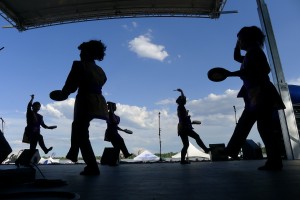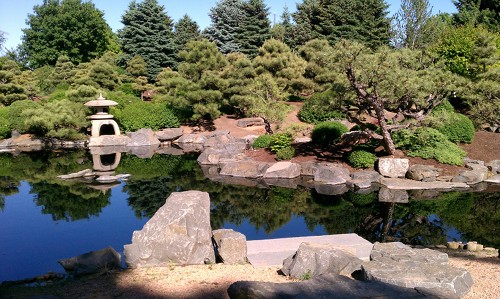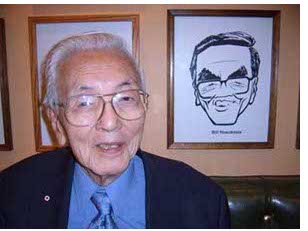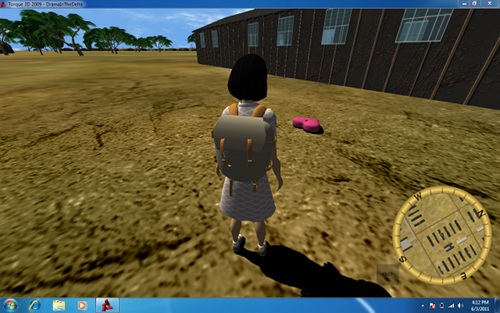December 31, 2010

Unlike other Asian cultures, the Japanese don't celebrate Lunar New Year. Instead, they celebrate the Western calendar New Year, January 1, and some of the special traditions for the holiday, called "
Oshogatsu," have been handed down to Japanese Americans over the past century.
Japanese New Year's traditions are different from Western (or at least, American) ones: First of all, New Year's Eve isn't the big holiday, and the focus isn't on partying and waiting until midnight on Dec. 31 to watch the Times Square ball slide down, or to see fireworks or make hearty toasts. A lot of us do, because we go to parties to celebrate with friends -- after all, we
are Japanese
American.
In Japan, New Year's Eve and the days leading up to it are all about cleaning house, cleaning yourself and your soul, putting your business in order to prepare for the new year. It doesn't sound like much fun. And traditionally, people spend New Year's Eve quietly at home with family or friends. There are events, such as the release of thousands of balloons at Tokyo's Zojoji temple to pray for world peace -- pretty different from Times Square, huh? My mom's hometown of Nemuro is at the easternmost tip of the northern island of Hokkaido, and thousands of people gather on Cape Nosappu outside of town past midnight on January 1, to see the first sunrise of the new year in Japan. Buddhist temples ring their bell at midnight to mark the start of the new year, a very spiritual sound.
There are other festive events throughout Japan too, with live music and fireworks just like in the US -- it's not all traditional.
By the time the clock ticks over into the new year, Japanese have spruced up their house with traditional decorations made of pine, bamboo and plum trees to bring good luck. On New Year's Eve, families settle in with special
toshikoshi soba noodles to bring long life, and watch Kohaku Utagassen, a men versus women singing contest that's like karaoke on serious steroids featuring the country's biggest enka (a traditional style of pop music) and J-pop stars. This show has been aired on New Year's Eve since the end of World War II, and for decades it was Japan's equivalent of the Super Bowl in popularity.
Denver's Japanese community has held a Kohaku Utagassen competition for many years too.
The main event in Japan isn't New Year's Eve and the midnight celebrations. It's New Year's Day, or
Oshogatsu, and not because of college sports contests. The first days of January represent the start of a clean slate for everyone, and a time to celebrate family and friends by visiting people and wish everyone well. January 1 is also the day for a family feast that can put American Thanksgiving to shame.
 It struck me towards the end of the first day of the Colorado Dragon Boat Festival that the clash of cultures I had just witnessed perfectly encapsulates why I’ve been a volunteer for this event since it was started in 2001.
(Full disclosure: Last year, my partner Erin Yoshimura took on the role as executive director of the festival, after volunteering from the beginning. I help out with media, the website and emceeing on the main stage.)
As the first day of the two-day event came to a close, the main stage lineup included a sampling of performers from the festival’s very popular Cultural Unity stage, a showcase of Colorado’s diverse hip-hop community.
The hip-hop sampler was fantastic – and showed why their stage is always so jammed that you can barely see through the crowds surrounding the tent, especially when the dancers are spinning on the ground.
The elevated main stage offered an eye-popping view for the audience, most of whom hadn’t gone by the Cultural Unity area before. The performance was a 20-minute introduction to the artistic principles and driving aesthetics of hip-hop culture, starting with naked rhythm from a conga drum, then showing the evolution of the rhythm into the DJ’s scratching with turntables and vinyl records.
Then the B-boys and B-girls assembled around the stage in a half-circle took turns strutting their stuff to the rhythmic riffing, spinning, flipping and contorting their bodies into unbelievably elastic poses and leaving the audience agog.
The set emphasized the multicultural appeal of hip-hop and pointed out how the performers on stage with him ran the ethnic gamut: Asian, Caucasian, African American, Latino.
Following the Cultural Unity sampler, which drew a huge crowd to the stage, most of the audience stayed for the Colorado Okinawa Kenjinkai, a group of women from Okinawa who preserve the traditional dances of Okinawa, a culture that’s distinct from Japan.
It struck me towards the end of the first day of the Colorado Dragon Boat Festival that the clash of cultures I had just witnessed perfectly encapsulates why I’ve been a volunteer for this event since it was started in 2001.
(Full disclosure: Last year, my partner Erin Yoshimura took on the role as executive director of the festival, after volunteering from the beginning. I help out with media, the website and emceeing on the main stage.)
As the first day of the two-day event came to a close, the main stage lineup included a sampling of performers from the festival’s very popular Cultural Unity stage, a showcase of Colorado’s diverse hip-hop community.
The hip-hop sampler was fantastic – and showed why their stage is always so jammed that you can barely see through the crowds surrounding the tent, especially when the dancers are spinning on the ground.
The elevated main stage offered an eye-popping view for the audience, most of whom hadn’t gone by the Cultural Unity area before. The performance was a 20-minute introduction to the artistic principles and driving aesthetics of hip-hop culture, starting with naked rhythm from a conga drum, then showing the evolution of the rhythm into the DJ’s scratching with turntables and vinyl records.
Then the B-boys and B-girls assembled around the stage in a half-circle took turns strutting their stuff to the rhythmic riffing, spinning, flipping and contorting their bodies into unbelievably elastic poses and leaving the audience agog.
The set emphasized the multicultural appeal of hip-hop and pointed out how the performers on stage with him ran the ethnic gamut: Asian, Caucasian, African American, Latino.
Following the Cultural Unity sampler, which drew a huge crowd to the stage, most of the audience stayed for the Colorado Okinawa Kenjinkai, a group of women from Okinawa who preserve the traditional dances of Okinawa, a culture that’s distinct from Japan.






 Japanese Americans know about internment. My wife Erin's parents, grandparents and great-grandparents on both sides were rounded up from Sacramento County, Calif. and eventually imprisoned at Rohwer, one of two concentration camps in Arkansas built during World War II to house Japanese Americans out of fear and racial hysteria. There were 10 in all, including Camp Amache in desolate southeastern Colorado. (Note: There's been a gradual move towards the use of the term "concentration camps" because that's the term the U.S. government used for them when they weren't using euphemisms like "assembly center" or "relocation center.")
For many older Japanese Americans, the first thing they ask of each other when they meet other JAs is, "what camp was your family in?" and they're not talking about summer camp.
Japanese Americans know about internment. My wife Erin's parents, grandparents and great-grandparents on both sides were rounded up from Sacramento County, Calif. and eventually imprisoned at Rohwer, one of two concentration camps in Arkansas built during World War II to house Japanese Americans out of fear and racial hysteria. There were 10 in all, including Camp Amache in desolate southeastern Colorado. (Note: There's been a gradual move towards the use of the term "concentration camps" because that's the term the U.S. government used for them when they weren't using euphemisms like "assembly center" or "relocation center.")
For many older Japanese Americans, the first thing they ask of each other when they meet other JAs is, "what camp was your family in?" and they're not talking about summer camp.
 Unlike other Asian cultures, the Japanese don't celebrate Lunar New Year. Instead, they celebrate the Western calendar New Year, January 1, and some of the special traditions for the holiday, called "Oshogatsu," have been handed down to Japanese Americans over the past century.
Japanese New Year's traditions are different from Western (or at least, American) ones: First of all, New Year's Eve isn't the big holiday, and the focus isn't on partying and waiting until midnight on Dec. 31 to watch the Times Square ball slide down, or to see fireworks or make hearty toasts. A lot of us do, because we go to parties to celebrate with friends -- after all, we are Japanese American.
In Japan, New Year's Eve and the days leading up to it are all about cleaning house, cleaning yourself and your soul, putting your business in order to prepare for the new year. It doesn't sound like much fun. And traditionally, people spend New Year's Eve quietly at home with family or friends. There are events, such as the release of thousands of balloons at Tokyo's Zojoji temple to pray for world peace -- pretty different from Times Square, huh? My mom's hometown of Nemuro is at the easternmost tip of the northern island of Hokkaido, and thousands of people gather on Cape Nosappu outside of town past midnight on January 1, to see the first sunrise of the new year in Japan. Buddhist temples ring their bell at midnight to mark the start of the new year, a very spiritual sound.
There are other festive events throughout Japan too, with live music and fireworks just like in the US -- it's not all traditional.
By the time the clock ticks over into the new year, Japanese have spruced up their house with traditional decorations made of pine, bamboo and plum trees to bring good luck. On New Year's Eve, families settle in with special toshikoshi soba noodles to bring long life, and watch Kohaku Utagassen, a men versus women singing contest that's like karaoke on serious steroids featuring the country's biggest enka (a traditional style of pop music) and J-pop stars. This show has been aired on New Year's Eve since the end of World War II, and for decades it was Japan's equivalent of the Super Bowl in popularity.
Unlike other Asian cultures, the Japanese don't celebrate Lunar New Year. Instead, they celebrate the Western calendar New Year, January 1, and some of the special traditions for the holiday, called "Oshogatsu," have been handed down to Japanese Americans over the past century.
Japanese New Year's traditions are different from Western (or at least, American) ones: First of all, New Year's Eve isn't the big holiday, and the focus isn't on partying and waiting until midnight on Dec. 31 to watch the Times Square ball slide down, or to see fireworks or make hearty toasts. A lot of us do, because we go to parties to celebrate with friends -- after all, we are Japanese American.
In Japan, New Year's Eve and the days leading up to it are all about cleaning house, cleaning yourself and your soul, putting your business in order to prepare for the new year. It doesn't sound like much fun. And traditionally, people spend New Year's Eve quietly at home with family or friends. There are events, such as the release of thousands of balloons at Tokyo's Zojoji temple to pray for world peace -- pretty different from Times Square, huh? My mom's hometown of Nemuro is at the easternmost tip of the northern island of Hokkaido, and thousands of people gather on Cape Nosappu outside of town past midnight on January 1, to see the first sunrise of the new year in Japan. Buddhist temples ring their bell at midnight to mark the start of the new year, a very spiritual sound.
There are other festive events throughout Japan too, with live music and fireworks just like in the US -- it's not all traditional.
By the time the clock ticks over into the new year, Japanese have spruced up their house with traditional decorations made of pine, bamboo and plum trees to bring good luck. On New Year's Eve, families settle in with special toshikoshi soba noodles to bring long life, and watch Kohaku Utagassen, a men versus women singing contest that's like karaoke on serious steroids featuring the country's biggest enka (a traditional style of pop music) and J-pop stars. This show has been aired on New Year's Eve since the end of World War II, and for decades it was Japan's equivalent of the Super Bowl in popularity.